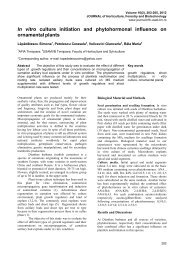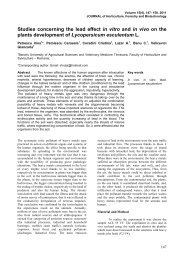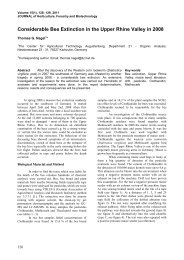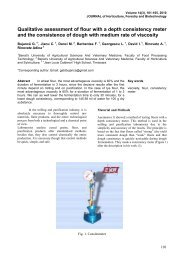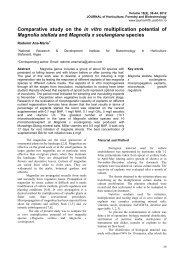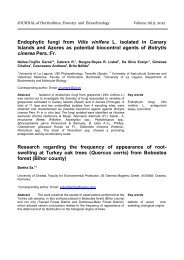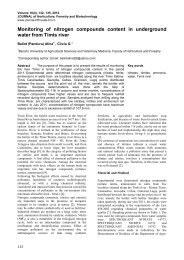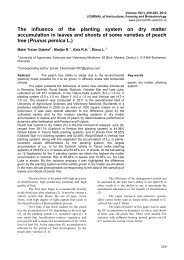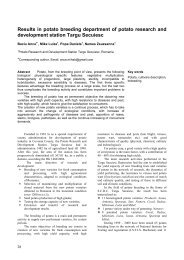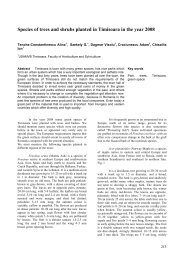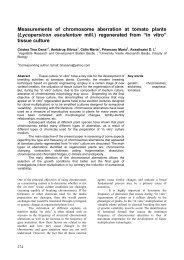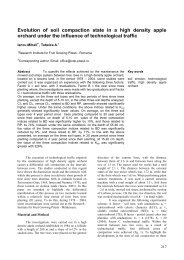Artemisia thuscula Cav.: antibacterial, antifungal activity of the plant ...
Artemisia thuscula Cav.: antibacterial, antifungal activity of the plant ...
Artemisia thuscula Cav.: antibacterial, antifungal activity of the plant ...
You also want an ePaper? Increase the reach of your titles
YUMPU automatically turns print PDFs into web optimized ePapers that Google loves.
Volume 16(1), 87-90, 2012<br />
JOURNAL <strong>of</strong> Horticulture, Forestry and Biotechnology<br />
www.journal-hfb.usab-tm.ro<br />
<strong>Artemisia</strong> <strong>thuscula</strong> <strong>Cav</strong>.: <strong>antibacterial</strong>, <strong>antifungal</strong> <strong>activity</strong> <strong>of</strong> <strong>the</strong><br />
<strong>plant</strong> extracts and associated endophytes<br />
Cosoveanu Andreea *1 , Da Silva, Evelin 2 , Gimenez Mariño, Cristina. 2 , Núñez Trujillo, Garoe 2 ,<br />
González-Coloma, Azucena 3 , Frias Viera I. 2 , Cabrera, R. 2<br />
1 .- University <strong>of</strong> Agricultural Sciences and Veterinary Medicine (USAMV), Faculty <strong>of</strong> Horticulture (Bucharest);<br />
2 University <strong>of</strong> La Laguna (ULL), Faculty <strong>of</strong> Biology, UDI Phytopathology (Tenerife); 3.- ICA- CSIC- (Madrid)<br />
*Corresponding author: andreeacosoveanu@gmail.com<br />
Abstract In this paper we are presenting preliminary results for <strong>the</strong><br />
<strong>antifungal</strong> and antibacterian <strong>activity</strong> <strong>of</strong> <strong>the</strong> <strong>Artemisia</strong> <strong>thuscula</strong> <strong>Cav</strong>. all<br />
toge<strong>the</strong>r with <strong>the</strong> endophytic communities encountered in symbiosis with this<br />
specie. This <strong>plant</strong> is endemic for <strong>the</strong> Canary Islands and it is recognised for its<br />
traditional medicinal use (like o<strong>the</strong>r species <strong>of</strong> <strong>the</strong> same genus in <strong>the</strong> rest <strong>of</strong><br />
<strong>the</strong> world) and for being a functional repellent <strong>of</strong> insects.<br />
The ethanol extracts tested showed an interesting <strong>activity</strong> against <strong>the</strong><br />
phytopathogenic fungi Fusarium monilforme, F. solani and F. oxysporum and<br />
antibiotic <strong>activity</strong> against 2 Gram-positive bacteria: Bacillus cereus and<br />
Streptomyces griseus, in an primary screening.<br />
The diversity <strong>of</strong> endophytes found in this <strong>plant</strong>, especially in <strong>the</strong> roots, showed<br />
promising results supporting fur<strong>the</strong>r work on this species.<br />
Key words<br />
<strong>Artemisia</strong><br />
<strong>antifungal</strong><br />
<strong>antibacterial</strong><br />
endophytes<br />
<strong>thuscula</strong>,<br />
<strong>activity</strong>,<br />
<strong>activity</strong>,<br />
The study <strong>of</strong> biodiversity related to agricultural<br />
landscapes has an increasing importance. Taking this<br />
into consideration, innovative tools are being used to<br />
manage diverse types <strong>of</strong> ‘eco agriculture’ spaces to<br />
increase production, biodiversity and benefit local<br />
people.<br />
Overuse and mismanagement <strong>of</strong> pesticides polluted<br />
water and soil [17], developed pest resistance,<br />
decreased natural enemies, and created human health<br />
related problems [22]. Agricultural pesticides may also<br />
kill non-target insects and weeds that constitute <strong>the</strong><br />
food base for insect- and grain-eating species [14].<br />
An interesting way <strong>of</strong> searching for bio rational<br />
pesticides is screening naturally occurring compounds<br />
in <strong>plant</strong>s [12]. Botanical insecticides are generally pest<br />
specific and, although natural products cannot<br />
automatically be assumed to be without risk, are<br />
relatively harmless against non-target organisms<br />
including humans, are also biodegradable and less<br />
harmful to <strong>the</strong> environment. Moreover, unlike<br />
conventional insecticides that are based on a single<br />
ingredient, <strong>plant</strong>-derived insecticides include an array<br />
<strong>of</strong> compounds that decrease <strong>the</strong> chance <strong>of</strong> pests to<br />
develop resistance. The interaction between <strong>plant</strong>s and<br />
insects is chemically mediated by secondary<br />
metabolites. Among <strong>the</strong> 500,000 estimated <strong>plant</strong><br />
secondary metabolites (PSMs), only few have been<br />
characterized. The main groups <strong>of</strong> PSMs are<br />
phenylpropanoids and phenolics, terpenoids and<br />
steroids, alkaloids and nitrogen compounds [10].<br />
<strong>Artemisia</strong> genus has species reported to have<br />
insecticidal properties and repellent <strong>activity</strong>. The<br />
application has been made in <strong>the</strong> form <strong>of</strong> maceration,<br />
decoction or infusion, essential oils and extracts<br />
In this context, <strong>the</strong> interest in <strong>the</strong> study <strong>of</strong> endophytic<br />
organisms in increasing. These organisms live inside<br />
<strong>plant</strong>s without causing any symptoms throughout <strong>the</strong>ir<br />
development, and participating actively in <strong>plant</strong><br />
protection against phytopatogenic agents[18]. They are<br />
important because <strong>the</strong>ir presence influences <strong>the</strong><br />
development <strong>of</strong> <strong>the</strong> <strong>plant</strong> on which <strong>the</strong>y live, which can<br />
benefit in different ways and also constitute an<br />
interesting source <strong>of</strong> new bioactive products<br />
(alkaloids, coumarins, cytochalasines, quinones,<br />
peptides, phenols, phenolic acids, semiquinones,<br />
steroids, terpenoids, xanthones and lactones).<br />
The term endophyte refers to a complex interaction<br />
(sometimes applied to a particular moment in which<br />
<strong>the</strong> host did not manifest reaction), where considered<br />
endophytic fungi belonging to different species, are<br />
more or less ubiquitous, more or less specific <strong>of</strong> <strong>the</strong>ir<br />
hosts and more or less selective in <strong>the</strong> <strong>plant</strong> organ on<br />
which <strong>the</strong>y live [9]).<br />
In relation to its role as a potential source <strong>of</strong> active<br />
compounds, <strong>the</strong> study <strong>of</strong> fungal endophytes <strong>of</strong> <strong>plant</strong>s<br />
has uncovered a range <strong>of</strong> metabolites with<br />
pharmacological interest [11], antimalarial [21],<br />
<strong>antifungal</strong> [23], antibiotics [20], antitumor [15].<br />
An example <strong>of</strong> high pharmacological interest<br />
compounds produced by endophytes is taxol, a<br />
diterpenoid very effective as an antitumor agent<br />
produced by <strong>the</strong> bark <strong>of</strong> Taxus brevifolia L., but which<br />
is also produced by one <strong>of</strong> its endophytes, Taxomyces<br />
andreanae [1]. In <strong>the</strong> species Taxus wallichiana<br />
87
Zuccarini <strong>the</strong> endophyte Pestalotiopsis microspora<br />
Spegazzini also produce this substance [16]. Fur<strong>the</strong>r<br />
examples <strong>of</strong> <strong>plant</strong> secondary metabolites detected in<br />
endophytic fungi include naphthodianthrones, such as<br />
hypericin. Hypericum species have been used for<br />
centuries against mild forms <strong>of</strong> depression and anxiety.<br />
An endophytic fungus from H. perforatum was found<br />
to produce hypericin in culture [1].<br />
Presence <strong>of</strong> endophytes in <strong>the</strong> <strong>plant</strong> can help increase<br />
<strong>the</strong> resistance to diseases caused by o<strong>the</strong>r fungal<br />
pathogens. Recent studies with <strong>the</strong> genus Phoma,<br />
shows <strong>the</strong>ir great <strong>activity</strong> against phytopathogenic<br />
fungi widely distributed such as Fusarium oxysporum<br />
Schltdl, Rhizoctonia solani Kühn or Colletotrichum<br />
gloeosporioides Penz [23].<br />
Therefore, endophytes represent a very interesting line<br />
<strong>of</strong> work for application in agriculture. The high<br />
probability that <strong>the</strong> metabolites <strong>of</strong> endophytic fungi<br />
have medicinal and industrial uses is an additional<br />
incentive to study this group [19]. Gunatilaka [11]<br />
made a review in which he presents nearly 230<br />
metabolites isolated from different endophytes, which<br />
gives us an idea <strong>of</strong> both structural diversity <strong>of</strong> <strong>the</strong>se<br />
compounds have <strong>activity</strong> and reinforces <strong>the</strong> interest in<br />
<strong>the</strong> study <strong>of</strong> <strong>the</strong>se organisms.<br />
Our research group has studied for several years<br />
endophytic fungal communities present in various <strong>plant</strong><br />
species in <strong>the</strong> Canary Islands, particularly in <strong>the</strong><br />
formation known as Laurel forest, present only in <strong>the</strong><br />
Macaronesian archipelagos <strong>of</strong> <strong>the</strong> Canaries, Azores and<br />
Madeira. We have isolated many species belonging to<br />
genera also present in tropical forests with very<br />
interesting properties, against several target organisms<br />
(phytopathogenic fungi, chewing insects, aphids and<br />
human parasites) [9].<br />
Therefore, we selected <strong>the</strong> <strong>plant</strong>s species <strong>Artemisia</strong><br />
<strong>thuscula</strong> <strong>Cav</strong>. (Asteraceae), a canarian endemism to<br />
study its endophytic fungal community. Our previous<br />
work has shown that ethanol extracts <strong>of</strong> this species are<br />
repellent against some insect pests <strong>of</strong> great economic<br />
interest, such as <strong>the</strong> banana weevil Cosmopolites<br />
sordidus Germar (unpublished data).<br />
The Asteraceae family, consisting <strong>of</strong> more than 800<br />
species that are widespread all over <strong>the</strong> world. Many<br />
species <strong>of</strong> this family have been known in traditional<br />
medicine as being anti malarial, anti cancer, antiviral,<br />
antitumoral etc [5, 3].<br />
Materials and Methods<br />
Samples <strong>of</strong> <strong>Artemisia</strong> <strong>thuscula</strong> were collected from<br />
four different locations in <strong>the</strong> north <strong>of</strong> <strong>the</strong> island <strong>of</strong><br />
Tenerife: Taganana, La Laguna and La Matanza,<br />
located 600 meters above sea level, and Las Aguas,<br />
located at <strong>the</strong> coast. Plant vouchers were prepared for<br />
au<strong>the</strong>ntication and conservation <strong>the</strong> Department <strong>of</strong><br />
Phytopathology, University <strong>of</strong> La Laguna, Tenerife.<br />
The <strong>plant</strong> organs were separated (root, stem and leaves)<br />
and dried at room temperature. After 48 hours <strong>of</strong><br />
maceration in ethanol, <strong>the</strong> extracts were filtered and <strong>the</strong><br />
solvent removed in a rotary vacuum evaporator.<br />
The target organisms were phytopathogenic fungi that<br />
cause severe damages in crops: three species <strong>of</strong><br />
Fusarium (F. moniliforme Sheldon, F. oxysporum fs.<br />
lycopersici Scheldt and F. solani Mart). We also tested<br />
on four species <strong>of</strong> bacteria: Bacillus cereus Frankland<br />
& Frankland and Streptomyces griseus Waksman and<br />
Henrici as Gram-positive and Escherichia coli Migula<br />
and Pseudomonas aeruginosa Migula as Gramnegative;<br />
provided by <strong>the</strong> Microbiology Lab <strong>of</strong> ULL<br />
The <strong>antifungal</strong> bioassays were carried out by means <strong>of</strong><br />
<strong>the</strong> biometric agar dilution method. The extracts<br />
obtained from <strong>the</strong> <strong>plant</strong> (Stock solution prepared at a<br />
concentration <strong>of</strong> 40mg/ml ethanol) were incorporated<br />
into <strong>the</strong> culture medium at 3 different concentrations<br />
(0.05mg, 0.1mg, 0.5mg, 1 mg/ml), prior to be poured<br />
in <strong>the</strong> Petri plates.<br />
The final concentration <strong>of</strong> ethanol in <strong>the</strong> medium was<br />
2%. In parallel, blank Petri dishes were prepared.<br />
Plates with 5 ml <strong>of</strong> medium were spot-inoculated at 8<br />
equidistant points and <strong>the</strong>n incubated in darkness at<br />
27°C for 48 hours. The diameter <strong>of</strong> <strong>the</strong> scanned colony<br />
images was measured with an image processing<br />
program. The parameter used to determine <strong>the</strong> <strong>activity</strong><br />
<strong>of</strong> <strong>the</strong> extracts is <strong>the</strong> percentage <strong>of</strong> growth inhibition,<br />
which is calculated by comparing <strong>the</strong> diameter <strong>of</strong> <strong>the</strong><br />
treated colonies with <strong>the</strong> control ones. The results are<br />
computed as IC 50 , <strong>the</strong> effective dose <strong>of</strong> an agonist that<br />
half maximally inhibits <strong>the</strong> pathogen. IC 50 was<br />
calculated with GraphPad S<strong>of</strong>tware by means <strong>of</strong> a<br />
regression curve (see table 1).<br />
The Kirky-Bauer [2] disc diffusion method was used to<br />
screen <strong>the</strong> <strong>antibacterial</strong> <strong>activity</strong> <strong>of</strong> <strong>plant</strong> extracts and<br />
performed by using LB medium [4]adjusting <strong>the</strong> pH to<br />
7 using a concentrated NaOH solution (1-5 M), prior to<br />
autoclaving. Broth cultures <strong>of</strong> 0,5 McFarland standards<br />
were made from each strain. 100 µl <strong>of</strong> bacterial<br />
suspension were uniformly swabbed on <strong>the</strong> LB<br />
medium (5ml) surface, and <strong>the</strong> inoculum was allowed<br />
to dry for 5 minutes. Sterilized filter paper discs<br />
(Whatman, 6mm in diameter) were placed on <strong>the</strong> LB<br />
surface previously treated with different<br />
concentrations <strong>of</strong> extracts (0,1-0,5-1-2-3-4-5 mg/disc).<br />
Two controls were used: one with chloranphenicol<br />
(1mg/disc) and ethanol (50µl/disc). The inoculated<br />
plates were stored at 25 ºC for S. griseus, P.<br />
aeruginosa, B. cereus and 28 ºC for E.coli, during 24h<br />
in inverted position.<br />
The average area <strong>of</strong> inhibition was measured by a<br />
modified Kirby-Bauer protocol, by counting <strong>the</strong><br />
distance between <strong>the</strong> margin <strong>of</strong> <strong>the</strong> disc and <strong>the</strong> end <strong>of</strong><br />
<strong>the</strong> inhibition zone.<br />
Results<br />
The ethanol extract <strong>of</strong> <strong>Artemisia</strong> <strong>thuscula</strong> shows<br />
<strong>antifungal</strong> and <strong>antibacterial</strong> <strong>activity</strong> (Table 2). Only<br />
Streptomyces griseus and Bacillus cereus, both gram<br />
88
positive, were affected by <strong>the</strong> extract. In <strong>the</strong> case <strong>of</strong> <strong>the</strong><br />
Gram-negative species, <strong>the</strong> inflorescences extract and<br />
leaves at 3, 4 and 5mg/ml were active (Table 2).<br />
Table 1<br />
IC 50 <strong>of</strong> A. <strong>thuscula</strong> extracts in agar difussion<br />
bioassays against fungal <strong>plant</strong> pathogens<br />
The strongest <strong>antifungal</strong> <strong>activity</strong> was shown by <strong>the</strong> leaf<br />
extract at 4 and 5mg/ml, with an IC 50 under 2mg/ml.<br />
(Table 1).<br />
The most active extract was from <strong>the</strong> leaves, which are<br />
a renewable biomass that can be harvested yearly.<br />
Fur<strong>the</strong>r research is needed in order to isolate <strong>the</strong> active<br />
compounds<br />
Table 2<br />
A. Thuscula extracts <strong>antibacterial</strong> <strong>activity</strong><br />
Doses: mg/disc<br />
Extract Bacteria 0,1 0,5 1 2 3 4 5<br />
Leaves<br />
Taganana<br />
Leaves<br />
Las Aguas<br />
Leaves<br />
La Laguna<br />
Inflores<br />
cences<br />
Las Aguas<br />
Roots<br />
La Laguna<br />
Stem<br />
La Laguna<br />
Extract<br />
Roots extract 181<br />
Branches extract 182<br />
Branches extract 182<br />
Phytopathongen<br />
s<br />
F. moniliforme<br />
F. moniliforme<br />
F. oxysporum<br />
IC50 mg/ml<br />
(conf. Levels)<br />
2,79 (0 – 6,03)<br />
1,2 (0,79-1,6)<br />
2,36 (0-13)<br />
Leaves extract 183 F. solani 1,2 (0-1,84)<br />
Leaves extract 183 F. oxysporum 1,2 (0,9-1,4)<br />
Leaves extract 777 F. oxysporum 1,57 (0 – 6,5)<br />
ST + + ++ ++ ++ ++ ++<br />
PS - - - - + + +<br />
EC - - - + + + +<br />
BC - + ++ ++ + ++ ++<br />
ST - - - ++ ++ ++ +++<br />
PS - - - - - - +<br />
EC - - - + + - -<br />
BC nt nt Nt + + + ++<br />
ST nt nt - - - + +<br />
PS nt nt - - - - -<br />
EC nt nt - - - + -<br />
BC nt nt - - - + +++<br />
ST nt nt - + + + ++<br />
PS - - - + + + +<br />
EC nt nt - - - + +<br />
BC nt nt + + ++ + +<br />
ST nt nt + + + + +<br />
PS nt nt - - - - +<br />
EC nt nt - - - - -<br />
BC nt nt + + + + +<br />
ST nt nt - - - - -<br />
PS nt nt - - - - -<br />
EC nt nt - - - - -<br />
BC nt nt - + + + ++<br />
ST =Streptomyces griseus; PS=Pseudomonas aeruginosa;<br />
EC=Escherichia coli; BC=Bacillus cereus<br />
(-) = no <strong>activity</strong>. + = 0-2mm ++ = 2-4 , +++ = plus 4 mm.<br />
(nt)= not tested<br />
From this <strong>plant</strong> species we have isolated 29 isolates: 20<br />
from roots, 7 from stems and 2 from leaves. 17 <strong>of</strong> <strong>the</strong><br />
isolates were obtained in PDA culture medium, and <strong>the</strong><br />
rest on YMA medium.<br />
Based on morphological characteristics <strong>of</strong> <strong>the</strong><br />
mycelium <strong>of</strong> <strong>the</strong> different isolates, we can establish<br />
three groups corresponding to each <strong>of</strong> <strong>the</strong> organs under<br />
study, which appears to confirm that endophytes can be<br />
host, tissue or organ specific.<br />
In <strong>the</strong> isolates obtained from root and leaf samples,<br />
whitish and cottony mycelia predominated, while <strong>the</strong><br />
mycelia <strong>of</strong> <strong>the</strong> endophytes isolated from <strong>the</strong> stem<br />
presented hard consistency and crust appearance.<br />
Few isolates have reproductive structures that facilitate<br />
<strong>the</strong>ir identification, <strong>the</strong>refore we have to rely on<br />
molecular techniques, which are in process.<br />
The <strong>antibacterial</strong> and <strong>antifungal</strong> effects shown by this<br />
<strong>plant</strong> toge<strong>the</strong>r with <strong>the</strong> diversity <strong>of</strong> <strong>the</strong> endophyte<br />
community encountered gives an added value to <strong>the</strong><br />
study <strong>of</strong> <strong>plant</strong> and fungal biodiversity.<br />
References<br />
1.Aly, A. H.; Debbab, A.; Kjer , J. & Proksch, P.<br />
(2010). Fungal Diversity, 41:1–16<br />
2.Bauer, A. W., W. M. M. Kirby, J. C. Sherris, and M.<br />
Turck. 1966. Antibiotic susceptibility testing by a<br />
standardized single disk method. Am. J.<br />
Clin. Pathol. 36:493-496<br />
3.Benjumea, D., S. Abdala, F. Hernandez-Luis, P.<br />
Pérez-Paz, D. Martin-Herrera (2005) Diuretic <strong>activity</strong> <strong>of</strong><br />
<strong>Artemisia</strong> <strong>thuscula</strong>, an endemic canary species. Journal<br />
<strong>of</strong> Ethnopharmacology, Volume 100, Issues 1–2, 22:<br />
205-209<br />
4.Bertani, G. 1952. "Studies on Lysogenesis. I. The<br />
mode <strong>of</strong> phage liberation bylysogenic Escherichia<br />
coli." J. Bacteriology, 62:293-300<br />
5.Bhakuni, R.S., Jain, D.C., Sharma, R.P., Kuma, S.,<br />
(2001). Secondary metabolites <strong>of</strong> <strong>Artemisia</strong> annua and<br />
<strong>the</strong>ir biological <strong>activity</strong>. Curr. Sci. 80, 35–48.<br />
6.Buchmann, S. L. & Nabhan, G. P. (1996). The<br />
forgotten pollinators. Washington, DC: Island Press.<br />
7.Gentile, A.; Rossi, M. S.; Cabral, D.; Craven, K. D. &<br />
Schardl, C. L. (2005). Origin, divergence, and<br />
phylogeny <strong>of</strong> Epichloe endophytes <strong>of</strong> native argentine<br />
grasses Molecular Phylogenetics and Evolution 35 (1):<br />
196-208.<br />
8.Gimenez C. (2006) Productos bioactivos de <strong>plant</strong>as<br />
Canarias y sus hongos endófitos: detección de la<br />
actividad y su utilización en el control de plagas y<br />
enfermedades agrícolas. Tesis doctoral Universidad de<br />
La Laguna.<br />
9.Giménez, C.; Cabrera, R.; Reina, M, & González-<br />
Coloma, A. (2007). Fungal Endophytes and <strong>the</strong>ir Role<br />
in Plant Protection. Current Organic Chemistry 11, 707-<br />
720<br />
89
10.Gonzalez-Coloma, A.; Reina M., Diaz C. E., Fraga<br />
B. M. (2009). Natural product-based biopesticides for<br />
insect control. Comprehensive natural products<br />
chemistry, 2nd edition. Edited by lew mander and hungwen<br />
liu. Elsevier, amsterdam<br />
11.Gunatilaka, A. A. L. (2006). Natural products from<br />
<strong>plant</strong>-associated microorganisms: distribution, structural<br />
diversity, bio<strong>activity</strong>, and implications <strong>of</strong> <strong>the</strong>ir<br />
occurrence. Journal <strong>of</strong> Natural Products 69 (3): 509-526.<br />
12.Isman, M.B. (2006). Annual Review <strong>of</strong> Entomology<br />
51: 45-66.<br />
13.Isman, M.B. (2008). Pest Management Science 64:<br />
8-11,1207.<br />
14.Kogan, M. (1998). Integrated pest management:<br />
historical perspectives and contemporary developments.<br />
Annual Review <strong>of</strong> Entomology 43: 243–270.<br />
(doi:10.1146/annurev.ento.43.1.243).<br />
15.Lu, S.; Sun, P.; Li, T.;<br />
, A.; Antus,<br />
S.; Krohn, K.; Draeger, S.; Schulz, B.; Yi, Y.; Li, L. &<br />
Zhang, W. (2011). Bioactive Nonanolide Derivatives<br />
Isolated from <strong>the</strong> Endophytic Fungus Cytospora sp.<br />
Journal <strong>of</strong> Organic Chemistry 76: 9699−9710.<br />
16.Metz, A.M.; Haddad, A.; Worapong, J.; Long, D.;<br />
Ford, E.J.; Hess, W.H. & Strobel, G.A. (2000).<br />
Induction <strong>of</strong> <strong>the</strong> sexual stage <strong>of</strong> Pestalotiopsis<br />
microspora, a taxol-producting fungus. Microbiology<br />
146: 2079-2089.<br />
17.Millennium Ecosystem Assessment (MA) 2005<br />
Ecosystems and human well-being: syn<strong>the</strong>sis.<br />
Washington, DC: World Resources Institute.<br />
18.Schulz, B. & Boyle, C. (2005). Review <strong>the</strong><br />
endophytic continuum. Mycol. Res. 109: 661-686.<br />
19.Strobel ,G.A. (2003). Endophytes as sources <strong>of</strong><br />
bioactive products. Microbes and Infection 5: 535-544.<br />
20.Strobel, G.; Daisy, B.; Castillo U. & Harper, J.<br />
(2004). Natural Products from Endophytic<br />
Microorganisms. Journal <strong>of</strong> Natural Products 67: 257-<br />
268.<br />
21.Tansuwan, S.; Pornpakakul, S.; Roengsumran, S.;<br />
Petsom, A.; Muangsin, N. ; Sihanonta, P. & Chaichit, N.<br />
(2007). Antimalarial Benzoquinones from an<br />
Endophytic Fungus, Xylaria sp. Journal <strong>of</strong> Natural<br />
Products 70: 1620–1623.<br />
22.Valladares, G.; Garcin, L.; Defagó, M.T.; Carpinella,<br />
C. & Palacios, S. (2003). Actividad antialimentaria e<br />
insecticida de un extracto de hojas senescentes de<br />
Melia azedarach (Meliaceae). Rev. Soc. Entomol.<br />
Argent. 62 (1-2): 53-61.<br />
23.Wang, L-W.; Xu, B-G.; Wang, J-Y.; Su, Z-Z.;<br />
Lin, F-C.; Zhang, C-L. & Kubicek, C.P. (2012).<br />
Bioactive metabolites from Phoma species, an<br />
endophytic fungus from <strong>the</strong> Chinese medicinal <strong>plant</strong><br />
Arisaema erubescens. Applied Microbiology and<br />
Biotechnology 93:1231–1239.<br />
This publication has been financed by <strong>the</strong> project:<br />
‘Bioprospection <strong>of</strong> endophytes in medicinal <strong>plant</strong>s for<br />
biopesticides production’ MCIN- FCCI. 2009. Ref.<br />
ACI2009-0900<br />
90



